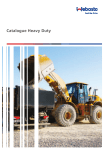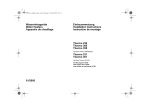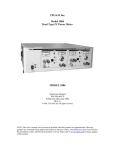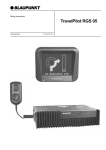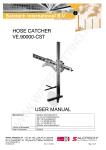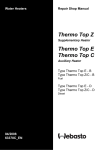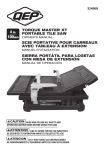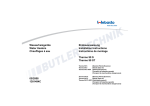Download Webasto Thermo Top C - PME Operating instructions
Transcript
Thermo Top C / Thermo Top E 1 Statutory regulations governing installation Statutory regulations governing installation 1.1. Statutory regulations governing installation The Thermo Top C and Thermo Top E heaters have been type-tested and approved in accordance with EC Directives 72/245/EEC (EMC) and 2001/56/EC (heater) with the following EC permit numbers: e1* 72/245*95/54*1232*02 e1*2001/56*0002*00 e1*2001/56*0003*00 Installation is governed above all by the provisions in Annex VII of directive 2001/56/EC. NOTE: The provisions of these Directives are binding within the territory governed by EU Directive 70/156/EEC and should similarly be observed in countries without specific regulations. (Extract from Directive 2001/56/EC Annex VII) 1.7.1. A clearly visible indicator within the user's field of vision must show when the heater is switched on or off. 2. Regulations for installation in the vehicle 2.1. Scope 2.1.1. Subject to the provisions of para. 2.1.2, internal combustion heaters must be installed in accordance with the requirements contained in the present Annex. 2.1.2. In the case of vehicles of class O (trailers) with heaters for liquid fuel, it is presumed that these vehicles comply with the requirements in the present Annex. 2.2. Position of the heater 2.2.1. Parts of the vehicle body and other components in the immediate vicinity of the heater must be protected against excessive heat and the danger of contamination by fuel or oil. 2.2.2. The internal combustion heater must not pose a fire hazard even when overheated. This requirement is deemed to have been met if care is taken during installation to ensure an adequate distance from all parts, as well as adequate ventilation and if fire-resistant materials or heat shields are used. 2.2.3. In vehicles of classes M2 and M3, the heater must not be installed in the passenger compartment. However, it is permissible to use a unit in a tightly sealed enclosure which also meets with the conditions in para. 2.2.2. 2.2.4. The plate in accordance with para. 1.4 (rating plate) or a duplicate thereof (duplicate rating plate) must be fitted in such a way that it is still clearly legible when the heater has been installed in the vehicle. 2.2.5. When positioning the heater, all due precautions must be taken to minimize all risk of bodily injury, as well as damage to items in the vehicle. 2.3. Fuel supply 2.3.1. The fuel filler neck must not be located in the passenger compartment and must have a tightly fitting cap to prevent any fuel leakages. 2.3.2. The type of fuel and the fuel filler neck must be clearly identified on heaters for liquid fuel, in which the fuel supply is separate from the fuel supply for the vehicle. 2.3.3. A sign must be affixed to the fuel filler neck warning that the heater must be switched off before refuelling. A corresponding warning must also be included in the manufacturer's operating instructions. 29 Statutory regulations governing installation 2.4. Exhaust system 2.4.1. The exhaust outlet must be positioned in such a way that exhaust gases cannot enter the vehicle via ventilation devices, hot-air inlets or window openings. 2.5. Combustion air inlet 2.5.1. The air for the combustion chamber of the heater must not be extracted from the passenger compartment of the vehicle. 2.5.2. The air inlet must be positioned in such a way that it cannot be obstructed by other objects. 2.6. Heating air inlet 2.6.1. The supply of heating air must consist of either fresh air or recirculated air and must be taken from a clean area which cannot be contaminated by exhaust fumes from the engine, the internal combustion heater or any other source in the vehicle. 2.6.2. The inlet line must be protected by a grating or other appropriate means. Thermo Top C / Thermo Top E IMPORTANT: Non-compliance with the installation instructions and the warnings contained therein will lead to the exclusion of all liability by Webasto. The same also applies if repairs are not undertaken by professionals or without using genuine spare parts. This invalidates the type approval for the heater and its homologation / EC type permit. NOTE: Contrary to the provisions of para. 2.2.3, the heater may not be installed in the passenger compartment of vehicles of classes M1 and N. However, it is permissible to use a unit in a tightly sealed enclosure which also meets with the conditions in para. 2.2.2. 1.2. General requirements 1.2.1. Exhaust emissions Exhaust lines must be routed at a sufficient distance (at least 20 mm) from all heat-sensitive vehicle parts (underbody protection, plastic parts, …). 2.7. Heating air outlet 2.7.1. Hot-air lines within the vehicle must be routed or protected in such a way as to exclude all risk of injury or damage due to direct contact. 2.7.2. The air outlet must be arranged or protected so that it cannot be obstructed by other objects. 2.8. Automatic control of the heating system When the engine stops, the heating system must switch off automatically and the fuel supply must be interrupted within 5 seconds. The heating system may remain in operation if a manual unit has already been activated. 30 1.2.2. Fuel lines Fuel lines must always be routed through cool areas in order to prevent the formation of bubbles due to heating up. Thermo Top C / Thermo Top E 2 Use / version Use / version 2.1. Use of the water heaters The Webasto Thermo Top C and E water heaters are used in combination with the onboard heating system – to heat the passenger compartment, – to defrost the vehicle windows and – to preheat water-cooled engines. 2.2. Version Thermo Top C - B auxiliary heating Water heater for "petrol" fuel Thermo Top C - D auxiliary heating Water heater for "diesel" fuel The water heaters operate independently of the engine and are connected to the cooling system, the fuel system and the electrical system of the vehicle. Thermo Top C - PME auxiliary heating Water heater for "biodegradable diesel" fuel Thermo Top E - B auxiliary heating Water heater for "petrol" fuel Thermo Top E - D auxiliary heating Water heater for "diesel" fuel The Thermo Top C and Thermo Top E water heaters are designed for 12 Volt operation. 31 Installation position 3 Thermo Top C / Thermo Top E Installation position The water heater must be installed outside the passenger compartment. The heaters are preferably installed in the engine compartment, under the front fender where they are protected from splashing water or on the splashboard. The heaters must be installed as low as possible to permit automatic bleeding of the heater and circulation pump. This is particularly important as the circulation pump is not self-priming. IMPORTANT: The openings of the water ports must not point downwards in any installed position. IMPORTANT: The heaters must not be installed: – in the immediate vicinity of or above hot parts, – in areas directly exposed to splashing water from the wheels, – below the fording line of the vehicle. 32 Fig. 1: Installation positions Thermo Top C / Thermo Top E Installation position 1 2 3 4 5 6 Fig. 2: Circulation pump Fuel filler neck Water outlet connector Exhaust outlet connector Combustion air inlet Water inlet connector Installation drawing for Thermo Top E and Z/C 33 Rating plate 4 Rating plate The rating plate must be positioned so that it cannot be damaged and must still be clearly legible when the heater is installed (otherwise a duplicate rating plate must be used). Inapplicable years must be erased from the rating plate. 34 Thermo Top C / Thermo Top E Thermo Top C / Thermo Top E 5 Holder Holder The holder must be secured to the car body or an intermediate holder with at least four M6 screws. Washers with a minimum diameter of 22 mm must be used if the body surfaces are plane. The holder must not be secured to the car body with self-tapping screws. The holder must be correctly machined in compliance with the minimum bending radii and in accordance with the technical rules. 35 Example for installation in a passenger car 6 1 2 3 4 5 6 7 Example for installation in a passenger car Radiator Cooling water thermostat Water pump (of the engine) Engine with standard equipment Water heater Battery Fuse holder Fig. 3: 36 Thermo Top C / Thermo Top E 8 9 10 11 12 13 14 Control unit (in the heater) Relay (for vehicle fan) Regulating valve for vehicle heating Heat exchanger, vehicle heating Fan for vehicle heating Switch for vehicle heating fan Fuse bank in vehicle Example for installation of the Thermo Top C or E heater in a passenger car 15 16 17 18 19 20 Timer Fuel pickup Intake silencer, combustion air intake line Exhaust muffler Circulation pump Fuel metering pump Thermo Top C / Thermo Top E 7 Connection to the vehicle cooling system Connection to the vehicle cooling system The heaters are connected to the vehicle cooling system as shown in Figs. 3, 4 and 5. At least 4 litres of coolant must be circulated (Thermo Top C); 3 litres for Thermo Top E. 1 7 2 ϑ 3 4 The water hoses supplied by Webasto must always be used. If other hoses are used, they must at least comply with DIN 73411. The hoses must be routed without kinking and preferably uphill to ensure perfect bleeding. Hose connections must be supported by hose clips so they cannot slip off. 5 6 1 2 3 4 5 6 7 Equalizing reservoir Thermostat Engine Circulation pump Heater Heat exchanger Radiator Fig. 4: NOTE: Leaking cooling water must be collected in a suitable container. NOTE: The hose clips on the heater must be fitted between the flared neck and the heater. The hose clips must be tightened with a torque of 2.0 + 0.5 Nm. Care must be taken to bleed the cooling system before the heater is taken into service for the first time or after refilling with fresh cooling water. Heater and lines should be installed in such a way as to ensure static bleeding. Malfunctions due to overheating may occur during operation if the heater and lines have not been bled correctly. Installation in engine water circulation, "in-line integration" The heater must be integrated into the cooling circuit in the feed line to the on-board heat exchanger. 37 Connection to the vehicle cooling system 7.1. Relocating the circulation pump The circulation pump can be installed either in its intended position on the heater or separately from the heater, in the water circulation. Care must be taken to ensure without fail that water flows through the heater in the right direction (water outlet at the top / water inlet at the bottom), otherwise the heater will malfunction. Fig. 5: 38 Circulation pump U4847 Installation positions Thermo Top C / Thermo Top E Thermo Top C / Thermo Top E 8 Fuel connection Fuel connection 8.1. Fuel connection without non-return valve in tank The fuel supply for the heater is connected in the return line as shown in Fig. 3. 8.2. Fuel connection with non-return valve in tank or fuel connection for single-line fuel supply The tank connector with 90° outlet is installed in the tank fitting (Fig. 6). Fig. 6: Tank fitting with 90° outlet 39 Fuel connection 8.3. Fuel supply . Thermo Top C / Thermo Top E The values for the permissible pressure at the fuel delivery point are listed in the following table. Permissible fuel inflow height H (m) Max. perm. excess pressure (bar) in the fuel line l1 0.00 0.2 1.00 0.11 Permissible fuel suction height S (m) Max. perm. negative pressure (bar) in the fuel tank 0.00 -0.10 0.50 -0.06 1.00 -0.02 NOTE A fuel feed line can normally be identified from the installed fuel filter. Fuel may only be taken from the return line with the special Webasto fuel pickup (see Fig. 8). The fuel pickup must be fitted so that any air or gas bubbles are automatically discharged in the direction of the tank (see Fig. 8). l1 + l2 ≤ 7 m l1 ≤ 1.2 m l2 ≤ 5.8 m Fig. 7: 40 Fuel supply Air or gas bubbles may arise in the fuel line of the vehicle if there are leaks in the carburetor or vehicle fuel pump or if the ambient temperature is higher than the evaporation temperature of the fuel. The fuel pickup should not be located near the engine, as gas bubbles may form in the lines on account of heat radiated from the engine. This may cause problems during combustion. Thermo Top C / Thermo Top E Fuel connection 8.4. Fuel lines NOTE: The hose clips must be tightened with a torque of 1.0 + 0.4 Nm. Leaking fuel must be removed before starting the engine or heater. Only steel, copper and plastic lines of plasticized, light and temperaturestabilized PA 11 or PA 12 (e.g. Mecanyl RWTL) in accordance with DIN 73378 may be used for the fuel lines. to engine from tank Fig. 8: to metering pump Webasto fuel pickup When installing the heater in a vehicle with fuel injection system, it is therefore important to establish whether the fuel pump is located inside or outside the tank. If the fuel pump is located inside the tank, fuel can only be withdrawn from the return line. In this case, it must be ensured that the return line continues almost to the bottom of the tank. The return line must be extended if necessary. IMPORTANT: If PME (vegetable oil methyl ester) is used as fuel, care must be taken to ensure that the fuel lines and fuel filter are resistant to PME. Since the lines normally cannot be routed with a constant uphill gradient, the inside diameter must not be allowed to exceed a certain size. Air or gas bubbles will accumulate in lines with an inside diameter of more than 4 mm and cause malfunctions if the lines sag or run downwards. The diameters specified in Fig. 7 will ensure that bubbles do not form. The lines should not be routed downwards from the metering pump to the heater. Unsupported fuel lines must be secured to prevent them sagging. They must be installed in such a way that they cannot be damaged by flying chippings and high temperatures (exhaust line). 41 Fuel connection Thermo Top C / Thermo Top E 8.5. Connecting two pipes and a hose The correct procedure for connecting fuel lines with hosing is illustrated in Fig. 9. Thermo Top C / Thermo Top E - petrol Ensure that there are no leaks!! Preferably 15° - 90° Right Clip Wrong Bubble Fig. 9: Bubble Fig. 10: Metering pump DP 2 Installation position Thermo Top C / Thermo Top E - diesel Pipe / hose connection 8.6. Metering pump The metering pump is a combined delivery, metering and shutoff system and is subject to specific installation criteria (see Figs. 7, 10 and 11). 8.6.1. Installation position Before installing the metering pump, ensure that the maximum pressure occurring at the pickup point is less than 0.2 bar. It is advisable to install the metering pump in a cool place. The permissible ambient temperature must not exceed +20 °C at any time during operation. Metering pump and fuel lines must not be installed within range of radiated heat from hot vehicle parts. A heat shield must be used if applicable. 42 Fig. 11: Metering pump DP 30 Installation position The pump should preferably be installed near the tank. Thermo Top C / Thermo Top E Fuel connection 8.6.2. Installation and attachment The metering pump must be secured with a vibration-damping suspension. Its installation position is limited as shown in Figs. 10 and 11 in order to ensure effective auto-bleeding. 8.7. Sticker The sticker "Switch off heater before refuelling" must be affixed at a suitable point. 43 Combustion air supply 9 Thermo Top C / Thermo Top E Combustion air supply The intake opening for combustion air must be located so that it cannot become clogged with dirt. It must not point in the direction of travel. An intake line is required for combustion air. The withdrawal point for the combustion air must be located in a cool (temperature ≤ 20 °C) place where it is protected from splashing water and above the fording line of the vehicle. Under no circumstances may the combustion air be taken from areas occupied by people. A ventilation opening measuring at least 3 cm² is required if the heater is installed in an enclosed box. If the heater is installed in a common installation space near the vehicle tank, the combustion air must be taken in from the outside and the exhaust gas discharged into the atmosphere. The openings must be splash-proof. 9.1. Air intake silencer The air intake silencer must be installed in a position between 0° and 90° pointing downwards. Installation instructions Connect the slotted side (approx. 18 mm) of the combustion air intake line, max. 400 mm long, to the air intake port of the heater and secure it with the hose clip supplied. Turn the air intake silencer as far as possible into the unslotted end of the air intake line (it need not be secured additionally by means of a hose clip). IMPORTANT: Ensure an adequate distance from the exhaust system. 44 0-90° 0-90° Fig. 12: Air intake silencer Installation position Depending on the installation situation, the air intake silencer must be secured at a suitable point with the enclosed mounting clip or cable ties. 9.1.1. Securing the air intake silencer with the mounting clip – Drill a hole dia. 6.5 mm at a suitable point. – Press the mounting clip into the hole. – Fit the air intake silencer in the mounting clip. Thermo Top C / Thermo Top E 10 Exhaust line Exhaust line The exhaust line (inside diameter 22 mm) can be routed with several bends (270° altogether, minimum bending radius 50 mm). The opening of the exhaust pipe must not point in the direction of travel (see Fig. 14). The total length of the exhaust line must be not less than 500 mm. The maximum length equals 1000 mm. The exhaust muffler should preferably be installed near the heater, but at least 200 mm away from the latter. The exhaust muffler must not be installed near the intake opening for the combustion air. The exhaust muffler and exhaust line must not be secured to heatsensitive parts of the vehicle and must be kept at an adequate minimum distance of 20 mm from the latter. The opening of the exhaust pipe must be freely accessible and must not be directed towards any part of the vehicle. The exhaust pipe opening must remain at a sufficient distance (≥ 0.2 m) from the ground. The Thermo Top C / Thermo Top E heater must not be operated without the muffler. 6.5 Discharge direction almost vertical 90° ± 10° Fig. 14: Exhaust pipe opening Installation position Rigid pipes of unalloyed steel with a minimum wall thickness of 1.0 mm or flexible piping of alloyed steel only must be used as exhaust line. NOTE: Accumulated condensation in the exhaust line must be discharged immediately. A condensate drain hole may be drilled if necessary. Fig. 13: Exhaust muffler Direction of flow as desired 45 Electrical connections 11 Thermo Top C / Thermo Top E Electrical connections 11.1. Connection of control unit / heater The electrical connections on the heater are made as shown in Fig. 17. 11.2. Installation and connection of the timer The timer is installed as shown in Fig. 15. A drilling template is enclosed. 11.3. Connection of the summer / winter switch (optional) NOTE: The summer / winter switch cannot be connected if the Telestart is installed. The summer / winter switch is connected as shown in Figs. 16 and 17. The timer is connected as shown in the circuit diagram in Fig. 17. Timer connector vi br Strip S5 Fig. 15: Timer installation NOTE: Do not press on the display panel during installation. 46 Fig. 16: Connection of the summer / winter switch NOTE: The ends of lines br and vi are inserted in the insulating hose! Thermo Top C / Thermo Top E Electrical connections 11.4. Vehicle fan The vehicle fan is controlled via the vehicle fan relay, see circuit diagram in Fig. 17. NOTE: The connection in the control unit (heating) is dimensioned for one fan relay (I max = 0.5 A). 11.5. Installation of Telestart (optional) The Telestart is installed in accordance with its installation instructions. Proceed as directed in the operating and maintenance instructions to learn in the Telestart transmitter. 11.6. Installation of Thermo Call (optional) The Thermo Call is installed in accordance with the Thermo Call installation instructions. 47 Circuit diagrams 12 Thermo Top C / Thermo Top E Circuit diagrams 12.1. Legend for circuit diagrams: Troubleshooting Outside temperature Vehicle fan fuse installed in vehicle Optional Cable cross-sections 48 < 7.5 m 7.5 - 15 m 0.5 mm2 0.75 mm2 0.75 mm2 1.5 mm2 1.0 mm2 1.5 mm2 1.5 mm2 2.5 mm2 2.5 mm2 4.0 mm2 4.0 mm2 6.0 mm2 Cable colours bl br ge gn gr or rt sw vi ws blue brown yellow green grey orange red black violet white Item A1 A2 A3 B2 E F1 F2 F3 H1 K3 M1 M2 M3 P S1 S2 S5 X1 X2 X3 X4 X5 X6 X9 Y1 Designation Heater Control unit Connecting box Temperature sensor Glow plug / flame monitor Fuse 20A Fuse 1A Fuse 25A LED (in pos. P) Relay Motor Motor Motor Timer, digital Switch for vehicle fan Switch for vehicle fan Switch Plug connection, 6-pole Plug connection, 2-pole Plug connection, 2-pole Plug connection, 2-pole Plug connection, 2-pole Plug connection, 2-pole Plug connection, 4-pole Metering pump Comment Thermo Top E or Z/C Flat fuse DIN 72581 Part 3 Flat fuse DIN 72581 Part 3 Flat fuse DIN 72581 Part 3 Switch-on indicator Vehicle fan Combustion air fan Circulation pump Vehicle fan For programmed operation S1 or S2 depending on vehicle S1 or S2 depending on vehicle Summer / winter switch Water-repellent Water-repellent Water-repellent Water-repellent Water-repellent Water-repellent Thermo Top C / Thermo Top E Circuit diagrams X9 (75) 15 30 61 rt ϑ 2 1 F1 ge sw 3 A3 rt F2 2 X1 rt sw + 3 A2 1 rt OUT +15 rt P - I max. = 0.5 A gn/ws 86 87 85 4 87a K3 1 X3 2 1 2 1 2 1 2 X2 1 2 B X6 X5 X4 5 A X9 H1 C F3 6 30 br br br X1 1 sw 1 2 3 4 5 6 bl 2 X2 M Ventilation Heating vi br M3 Y1 S2 E 4 2 1 X3 X4 2 1 X5 M M1 2 M ϑ M2 B2 A1 br S5 br 1 S1 31 Fig. 17: Automatic circuit for Thermo Top C and E, 12 V timer (legend see page 48) 49 Initial start-up 13 Initial start-up NOTE: The safety instructions in the operating and maintenance instructions must be observed without fail. The operating and maintenance instructions must be read through without fail before starting the heater. After installing the heater, the water circulation and fuel supply system must be carefully bled, taking into account the directions of the vehicle manufacturer. All water and fuel connections must be checked for leaks and secure attachment during a trial run of the heater. If the heater switches to fault mode during operation, the fault must be located and remedied. 50 Thermo Top C / Thermo Top E Thermo Top C / Thermo Top E 14 Faults Faults 14.1. Fault lock-out due to faults in the heater Fuel is supplied for max. 180 seconds if the flame does not start to burn. Fuel is supplied for max. 85 seconds if the flame goes out during operation. The fuel supply is shut off immediately if the system overheats (temperature limiter is tripped). In all cases (except a fault in the combustion air fan), the heater continues to run for 120 seconds after a fault lock-out. The run-on time may vary, depending on the software version in the control unit. IMPORTANT: A warning is not displayed following a fault lock-out due to overheating. 14.2. Cancelling the fault lock-out The fault lock-out is cancelled as described in the operating and maintenance instructions. 51 Technical data 15 Thermo Top C / Thermo Top E Technical data 15.1. Technical data, Thermo Top C Except where limit values are specified, the technical data on the right refer to the usual heater tolerances of ± 10% at an ambient temperature of +20 °C and at nominal voltage. 15.1.1. Fuel for Thermo Top C (petrol) The fuel specified by the manufacturer may be used. 15.1.2. Fuel for Thermo Top C (diesel) The diesel fuel specified by the manufacturer may be used. When changing over to low-temperature fuel, the heater must be operated for approx. 15 minutes so that the fuel line and fuel pump are also filled with the new fuel. Negative influences due to additives are not known. Circulation pump Flow rate at 0.1 bar Nominal voltage Operating voltage range 4847 900 l/h 12 V 10.5 ... 15 V Nominal power consumption 14 W Dimensions, circulation pump Width 214 mm Height 106 mm Weight 168 mm Weight 52 0.3 kg Thermo Top C / Thermo Top E Heater Technical data Operation Thermo Top C - B Thermo Top C - D EC approval mark Type Heat output Water heater with evaporator-type burner Full load Part load Fuel Fuel consumption Thermo Top C - D e1 5.2 kW 2.5 kW Petrol Full load Part load Diesel 0.70 l/h 0.34 l/h 0.61 l/h 0.30 l/h Nominal voltage Operating voltage range 12 V 10,5 ... 15 V Nominal power consumption without circulation pump Full load (without vehicle fan) Part load Perm. ambient temperature: Heater: - Operation - Storage Metering pump: - Operation Perm. operating pressure (heat carrier) 28 W 18 W -40° ... +60°C -40° ... +120°C -40° ... +20°C -40° ... +60°C -40° ... +120°C -20° * ... +20°C 0.4 ... 2.5 bar Capacity of the heat exchanger 0.15 l Minimum capacity of the circulation 4.00 l Minimum flow rate for the heater CO2 in the exhaust gas (perm. function range) Heater dimensions (tolerance ± 3 mm) Weight Diesel/PME 250 l/h 8 ... 12.0% by vol. Width 214 mm Height 106 mm Weight 168 mm 2.9 kg * May only be operated with diesel / PME mixture containing < 50% PME. 53 Technical data Thermo Top C / Thermo Top E 15.2. Technical data, Thermo Top E Except where limit values are specified, the technical data on the right refer to the usual heater tolerances of ± 10% at an ambient temperature of +20 °C and at nominal voltage. 15.2.1. Fuel for Thermo Top E (petrol) The fuel specified by the manufacturer may be used. 15.2.2. Fuel for Thermo Top E (diesel) The diesel fuel specified by the manufacturer may be used. When changing over to low-temperature fuel, the heater must be operated for approx. 15 minutes so that the fuel line and fuel pump are also filled with the new fuel. Negative influences due to additives are not known. Circulation pump Flow rate at 0.1 bar Nominal voltage Operating voltage range 4847 900 l/h 12 V 10.5 ... 15 V Nominal power consumption 14 W Dimensions, circulation pump Width 214 mm Height 106 mm Weight 168 mm Weight 54 0.3 kg Thermo Top C / Thermo Top E Heater Technical data Operation Thermo Top E - B EC approval mark Type Heat output Water heater with evaporator-type burner Full load Part load Fuel Fuel consumption Full load Part load 4.2 kW 2.5 kW Petrol Diesel 0.56 l/h 0.34 l/h 0.49 l/h 0.30 l/h Nominal voltage 12 V Operating voltage range Nominal power consumption without circulation pump (without vehicle fan) Thermo Top E - D e1 10.5 ... 15 V Full load Part load Perm. ambient temperature: Heater: - Operation - Storage Metering pump: - Operation Perm. operating pressure (heat carrier) Capacity of the heat exchanger 23 W 18 W -40° ... +60°C -40° ... +120°C -40° ... +20°C -40° ... +60°C -40° ... +120°C -20° ... +20°C 0.4 ... 2.5 bar 0.15 l Minimum capacity of the circulation 3.00 l Minimum flow rate for the heater 250 l/h CO2 in the exhaust gas (perm. function range) Heater dimensions (tolerance ± 3 mm) Weight 8 ... 12.0% by vol. Width 214 mm Height 106 mm Weight 168 mm 2.9 kg * May only be operated with diesel / PME mixture containing < 50% PME. 55 Technical data 56 Thermo Top C / Thermo Top E




























